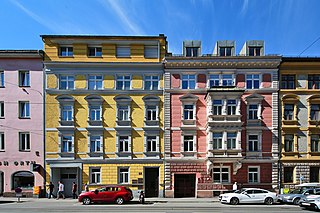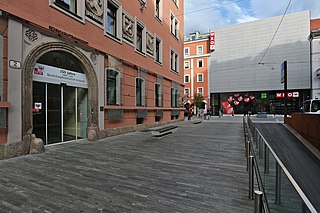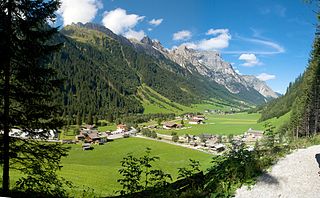
Innsbruck is the capital of Tyrol and the fifth-largest city in Austria. On the River Inn, at its junction with the Wipp Valley, which provides access to the Brenner Pass 30 km (19 mi) to the south, it had a population of 132,493 in 2018.

The Stubai Alps is a mountain range in the Central Eastern Alps of Europe. It derives its name from the Stubaital valley to its east and is located southwest of Innsbruck, Austria. Several peaks form the border between Austria and Italy. The range is bounded by the Inn River valley to the north; the Sill River valley (Wipptal) and the Brenner Pass to the east ; the Ötztal and Timmelsjoch to the west, and to the south by tributaries of the Passer River and Eisack.

The Stubai Valley or Stubaital is an alpine valley in Tyrol, Austria. It is the central valley of the Stubai Alps. The river Ruetz flows through the valley.

Serles is a mountain of the Stubai Alps in the Austrian state of Tyrol, Austria, between the Stubai Valley and Wipptal, near the Italian border. Its nickname is Altar von Tirol, literally the Altar of Tyrol. It has several lower peaks, including Sonnenstein to the north.

Fulpmes is a market town and a municipality in Stubaital, Tyrol, Austria. In 2015 it had a population of 4,250, of whom 14.5% did not have Austrian nationality. Fulpmes is the center of iron production in the area, and lies at the base of the Schlick 2000 ski area.

The Franz Senn Hut is a large and very popular Category I alpine hut in the Stubai Alps owned by the Austrian Alpine Club. It is a large, well-appointed hut, named after Franz Senn. Access is from Oberiss in the Oberbergtal off the Stubaital above Neustift.

The Bezirk Innsbruck-Land is an administrative district (Bezirk) in Tyrol, Austria. It encloses the Statutarstadt Innsbruck, and borders Bavaria (Germany) in the north, the district Schwaz in the east, South Tyrol in Italy to the south, and the district of Imst in the west.

Telfes is a village in the district Innsbruck Land in the Austrian state of Tyrol. It is situated in the Stubaital 11 km south of Innsbruck.

The Stubaitalbahn is an 18.2 km (11.31 mi) long narrow gauge interurban tram from Innsbruck to Fulpmes in Tyrol, Austria. In the city of Innsbruck, it uses the local tramway tracks. At the Stubaital station, the branch line-rated part begins. The meter gauge track starts at Innsbruck's Main station, crosses the Wilten district, and passes the villages of Natters, Mutters, Kreith, and Telfes. Between the Stubaital station and Fulpmes, the railway is single-track, but at nine stations: Sonnenburgerhof, Hölltal, Mutters, Nockhofweg Muttereralmbahn, Feldeler, Kreith, Telfer Wiesen, Luimes, Telfes, there are passing loops where the train usually uses the left-hand track. The final station, Fulpmes, has three tracks and one depot.

Inzing is a town in the Austrian Federal State of Tyrol.

Gries im Sellrain is a municipality in the Sellrain Valley in the western district of Innsbruck-Land. The village lies in the valley and the Melach River flows through it.

Grinzens is a municipality in the Austrian state of Tyrol in the district of Innsbruck-Land. As of January 2015, its population is 1414. It lies southwest of the city of Innsbruck at an elevation of 945 m.

Gschnitz is a municipality with 415 inhabitants in the south of North Tyrol.

Mieders is a municipality in the southern part of the district Innsbruck-Land in the Austrian state of Tyrol. It is located on the right side of the Stubaital 10.60 km south of Innsbruck.

Mühlbachl was a municipality in the district Innsbruck-Land located 15 km south of Innsbruck. Mühlbachl extended from the southern slopes of Schönberg im Stubaital along Matreiwald to Steinach and the Sill River flew through it. It had 1,349 inhabitants. On 1 January 2022 Mühlbachl and Pfons were merged into the municipality of Matrei am Brenner.

Sellrain is a municipality in the district of Innsbruck-Land in the Austrian state of Tyrol located 14.40 km (8.95 mi) southwest of Innsbruck in the Sellrain Valley. The River Melach and its tributary the Fotscherbach flow through it. Most inhabitants are farmers and also have another job in the neighboring Innsbruck. There are two Catholic churches in the village St. Quirin and St. Anna. They are both over 300 years old.
Schönberg im Stubaital is a municipality in the district of Innsbruck-Land, Tyrol, Austria. It is 9 km (5.6 mi) south of Innsbruck at the entrance of the Stubaital. The village was mentioned as “Schönenberge” for the first time in 1180.

Sankt Sigmund im Sellrain is a municipality in western Austria, in the district of Innsbruck-Land in the state of Tyrol located 23.3 kilometres (14.5 mi) southeast of Innsbruck, in the deepest part of the Sellrain Valley. It has a large area and the highest elevation. The main source of income is winter tourism.

The Stubai Hohenweg or Stubai highroute is a high-level footpath in Tyrol, Austria. It is approximately 80 km long, and a total ascent / descent of over 6,000 m. The trail can be completed in 8 or 9 days. It is designed to be a circular route around the Stubai valley. The trail starts in Neustift, but can be started from any hut on the trail, for example Fulpmes.
Kreuzjoch is the name of many summits and several mountain passes, predominantly in the Eastern Alps.






















